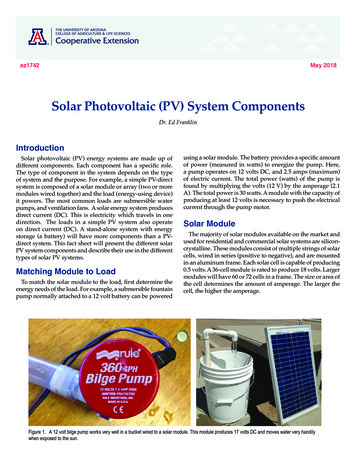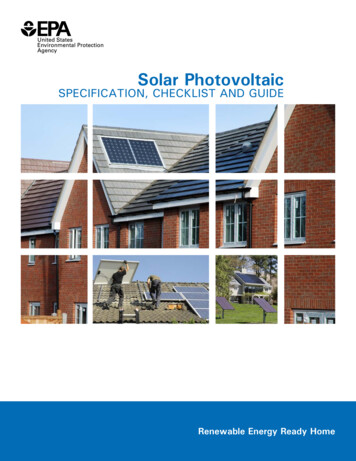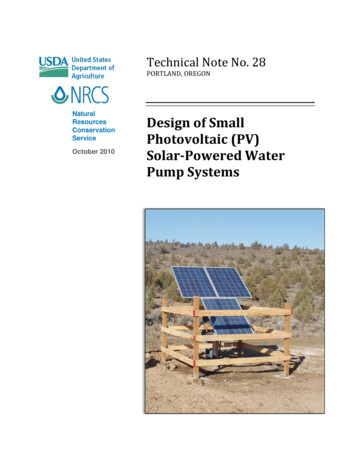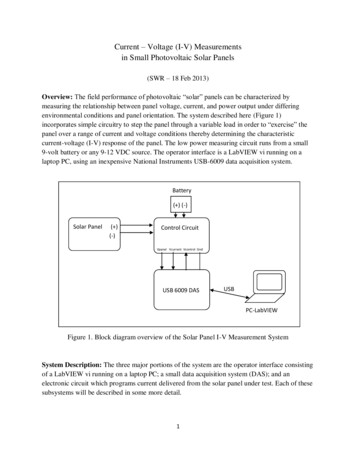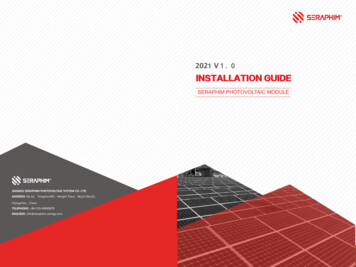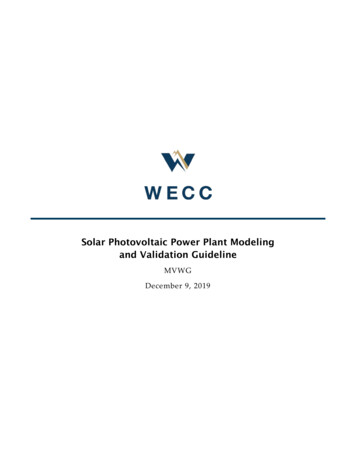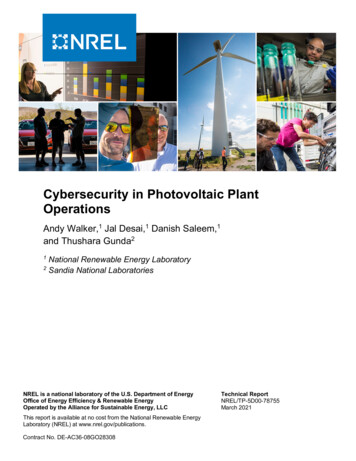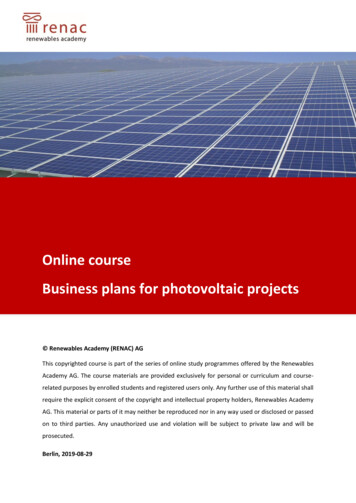
Transcription
Online courseBusiness plans for photovoltaic projects Renewables Academy (RENAC) AGThis copyrighted course is part of the series of online study programmes offered by the RenewablesAcademy AG. The course materials are provided exclusively for personal or curriculum and courserelated purposes by enrolled students and registered users only. Any further use of this material shallrequire the explicit consent of the copyright and intellectual property holders, Renewables AcademyAG. This material or parts of it may neither be reproduced nor in any way used or disclosed or passedon to third parties. Any unauthorized use and violation will be subject to private law and will beprosecuted.Berlin, 2019-08-29
Table of content1.Business plans for photovoltaic projects . 41.1 Introduction to the course . 41.2 Introduction to business plans . 51.3 Structure and design of a bankable business plan . 72.Key aspects of a bankable business plan in the PV market . 112.1 Key aspects of a bankable business plan in the PV market 1/5 .112.2 Key aspects of a bankable business plan in the PV market 2/5 .122.3 Key aspects of a bankable business plan in the PV market 3/5 .142.4 Key aspects of a bankable business plan in the PV market 4/5 .152.5 Key aspects of a bankable business plan in the PV market 5/5 .173.Business plans for a new project development company . 193.1 Business plans for a new project development company - example 1/3 .193.2 The structure of the new project development company: .193.3 Business plans for a new project development company - example 2/3 .223.4 Business plans for a new project development company – example 3/3 .234.Business plans for an investor into RE projects . 264.1 Business plans for an investor into RE projects - example 1/3 .264.2 Business plans for an investor into RE projects - example 2/3 .284.3 Business plans for an investor into RE projects - example 3/3 .295.Business plans for a solar EPC business . 315.1 Business plans for a solar EPC business - example 1/3 .315.2 Business plans for a solar EPC business, example 2/3 .335.3 Business plans for a solar EPC business - example 3/3 .346.Business plans for an Operation and Maintenance (O&M) contractor . 366.1 Business plans for an Operation and Maintenance (O&M) contractor – example 1/3.366.2 Business plans for an Operation and Maintenance (O&M) contractor- example 2/3 .386.3 Business plans for an Operation and Maintenance (O&M) contractor- example 3/3 .397.Business plans for an independent engineer . 417.1 Business description and company structure of an independent engineer .417.2 SWOT analysis for an independent engineer’s company.427.3 Marketing plan for an independent engineer’s company.437.4 Financial plan for an independent engineer.45Page 2 of 6929/08/2019Business plans for photovoltaic projects
8.Business plans for a specialist for inspection and acceptance tests . 478.1 Business description and company structure of a specialist for inspection andacceptance tests .478.2 SWOT analysis for a specialist for inspection and acceptance tests.488.3 Marketing plan for a specialist for inspection and acceptance tests .508.4 Financial plan for a specialist for inspection and acceptance tests .519.Business plans for a mechanical installer of PV plants . 539.5 Business description and company structure for a mechanical installer of PV plants .539.6 SWOT analysis for a mechanical installer of PV plants .559.7 Marketing plan for a mechanical installer of PV plants .569.8 Financial plan for a mechanical installer of PV plants .5810.Business plans for a SME for service and repair . 6010.1 Business description and company structure of a SME for service and repair .6010.2 SWOT analysis for a SME for service and repair .6110.3 Marketing plan for a SME for service and repair .6210.4 Financial plan for a SME for service and repair .6411.Business plans - Summary and further reading . 6611.1 Summary 1/2 .6611.2 Summary 2/2 .6711.3 Bibliography and further reading.69Page 3 of 6929/08/2019Business plans for photovoltaic projects
1. Business plans for photovoltaic projects1.1 Introduction to the courseThe aim of this part of the course is to obtain an understanding of business planning for different PVbusiness models.The course participants shall be enabled to develop business plans for the groups of actors consideredhere (project developer, investor, EPC contractor, O&M contractor). It is important to consider thatthe focus of this course is not on “how to write a business plan” but on “what are the PV market specifictasks to consider when preparing a business plan (BP) and entering the PV market”.Participants should already have some basic knowledge about the structure and content of businessplans e.g. obtained in other courses or via internet. With the gained knowledge they will be able toadequately consider the special features in the development of a BP for the market of medium andlarge-scale PV plants in emerging markets. In order to increase traceability, the group of actors arepresented and explained using an example for each group of actors.Page 4 of 6929/08/2019Business plans for photovoltaic projects
1.2 Introduction to business plansLearning objectives:Upon completion of this page you should be able to list the reasons, why a BP is essential for getting a business startedstate the different addressees of a BP and their motives and demands.state the BP requirementsA business plan is a formal statement of business goals, the reasons they are attainable, and plans forreaching them. It may also contain background information about the organization or team attemptingto reach those goals. Written business plans are often required to obtain a bank loan or other financing.A solid business plan should present a business in a credible, understandable and attractive manner tosomeone who is unfamiliar with the business1.This course is mainly focussing on business plans for the establishment of potential RE servicecompanies, but for reasons of completeness other business options such as component manufacturingor a pure play investment into an individual project are also mentioned.The addressees of a business plan for a renewable energy project are typically equity investors (suchas independent power producers), banks and lenders, providers of subsidies for new economicactivities, land owners, energy off-takers and other stakeholders with a strategic interest in theparticular business.Page 5 of 6929/08/2019Business plans for photovoltaic projects
Target group and requirements for a BP(Source: RENAC, 2018)An enterprise focused business plan would on the one hand make statements on a more superordinated business activity, such as the establishment of a PV module factory or the opening of an EPCcompany. A project-oriented business plan would on the other hand reflect the planning for anindividual solar project, such as the development and construction of a particular solar farm at aparticular site.Page 6 of 6929/08/2019Business plans for photovoltaic projects
In case of the establishment of a manufacturing or service business, the preparation of a business planrequires input from different disciplines, such as finance, operational planning, legal, and humanresources. Alternatively, in the case of a project-based business plan, a more project-related set ofinformation might be required such as meteorological data, soil reports, grid connection details or thenature of the electricity off-take agreement (power purchase agreement, PPA).Normally, concerned stakeholders want to evaluate the opportunities of a RE undertaking against theindividual risk that is involved for them. Planning horizons for business plans related to the finaloperation of PV plants can be very extensive, as expected component lifetimes and associated revenuestreams from selling the electricity generated can be up to 25 years long. For RE service enterprises,such as project developers, EPC providers or after sales services like O&M (Operation andMaintenance), the time frame to consider is much shorter and is normally in the 5 year range.1.3 Structure and design of a bankable business planLearning objectives:Upon completion of this page you should be able to outline a basic BPunderstand the different forms of BP designsThe elements of a business plan are greatly determined by the need of the target group, for which theBP is written. As outlined in the previous chapter typical target groups can be investors, banks andgovernment-agencies, but also land owners might be interested in understanding the exact purposefor which they are addressed to sell or rent their land on a longer-term basis.In almost every case, a BP must contain the following elements as a minimum requirement:Page 7 of 6929/08/2019Business plans for photovoltaic projects
1. Executive Summary2. Description of the business3. Analysis of the market and the position of competitors4. Marketing plan5. Operational plan6. Financial plan and financial analysis7. SWOT analysis8. Supporting documents and referencesBP elements. (Source: RENAC, 2018)Decision makers can only peruse a limited amount of business plans and a well-prepared executivesummary can certainly encourage further involvement with the matter. It cannot always be assumedthat the addressee of the BP is familiar with the business that is being presented, thus it is alwayshelpful to add a brief description of the business activity. While larger international banks normallyhave dedicated departments for (project) finance requisitions, it should not automatically be assumedthat all investors are completely familiar with the exact nature of the business that is being presentedas they often have an element of diversification within their portfolio. Finally, land owners orgovernment agencies may well be the target group where knowledge of RE undertakings is the leastpronounced.Page 8 of 6929/08/2019Business plans for photovoltaic projects
Operational plans and especially marketing plans are very interesting for decisions to be taken onmanufacturing and services. If an entrepreneur wants to fabricate PV components, he needs to havea clear idea of his sales and manufacturing volumes to optimise his factory, whereas the owner of a PVproject that sells electricity against a secured feed-in tariff (FIT) might not have to think too much aboutbroader sales and marketing activities. The provider of a service (such as EPC or O&M) will also needto take a close look at his marketing plan and his positioning in the competitive landscape.There is also some distinction when it comes to the financial analysis. Both groups, investors andlenders, are principally interested in understanding their particular risk during their respective timesof financial exposure. For example: a provider of debt will mostly care to have the debt repaid withinthe agreed tenure (say 5 to 15 years) and prefers being covered by a high DSCR (Debt Service CoverageRatio). An investor, on the other hand, might have a completely different period of time in mind whenevaluating a BP based on his individual exit strategy.Page 9 of 6929/08/2019Business plans for photovoltaic projects
Some investors only get involved in a business for a short time (e.g. the construction or founding phaseand maybe the first year of operation to demonstrate successful revenue creation) and expect to berewarded for taking the construction and the early phase operational and legal risks. Their buyer, i.e.a longer term holding investor (such as a pension fund in case of RE projects or a strategic investorbuying an EPC or O&M company), prefers to acquire such de-risked assets or business activities wit
3. Analysis of the market and the position of competitors 4. Marketing plan 5. Operational plan 6. Financial plan and financial analysis 7. SWOT analysis 8. Supporting documents and references BP elements. (Source: RENAC, 2018) Decision makers can only peruse a limited amount of business plans and a well-prepared executive

